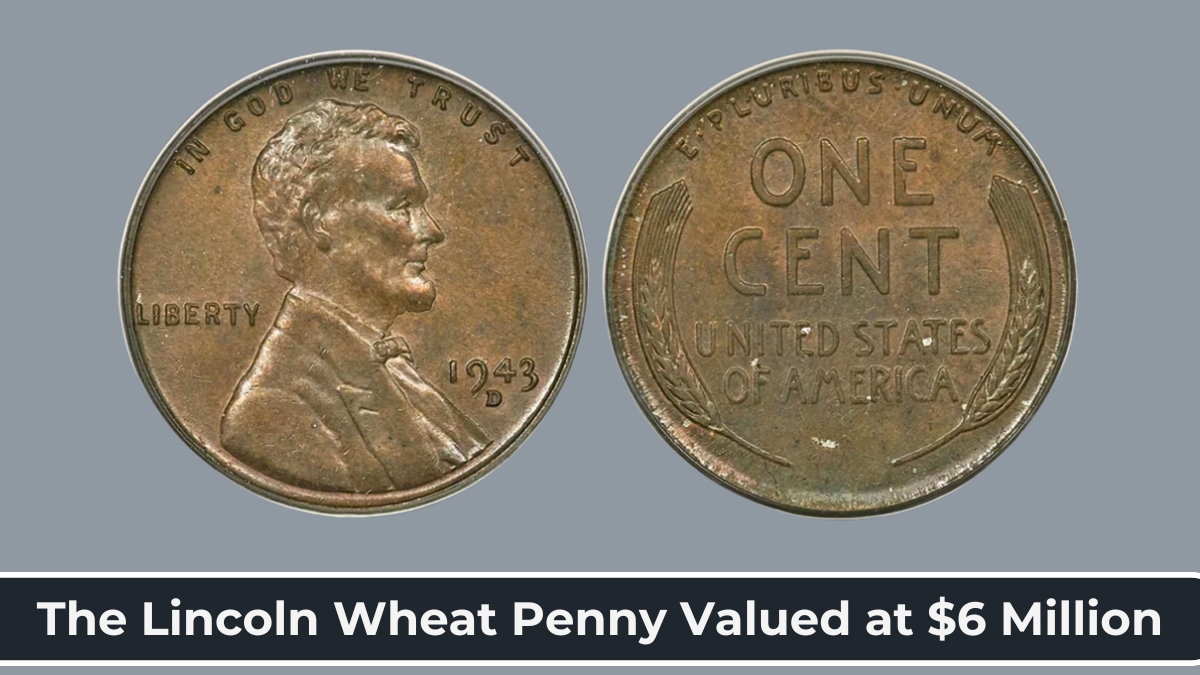In a world where digital transactions are becoming the norm, many people overlook pennies, often dismissing them as mere pocket change. However, some pennies—especially the Lincoln Wheat Penny—hold extraordinary value. Among these, the 1943 Copper Penny is one of the rarest and most valuable coins in American history, with an estimated worth of $6 million.
The Birth of an American Icon
The Lincoln Wheat Penny was introduced in 1909 to commemorate the 100th anniversary of Abraham Lincoln’s birth. Designed by Victor David Brenner, it became the first U.S. coin to feature a real person’s likeness, marking a major shift in American currency design.
The obverse (front) showcased a detailed portrait of Lincoln, while the reverse (back) displayed two wheat stalks, symbolizing the nation’s agricultural prosperity. This iconic design remained in circulation until 1958, when it was replaced by the Lincoln Memorial Penny.
The World War II Connection: A Rare Error
During World War II, the U.S. government needed to conserve copper for military supplies such as shell casings and electrical wiring. As a result, in 1943, the U.S. Mint switched from copper to zinc-coated steel for penny production. These new pennies had a silvery appearance instead of the usual copper color.
However, due to an accidental mistake, a few copper planchets (coin blanks) from 1942 remained in the minting presses. These copper planchets were struck with the 1943 date, creating one of the rarest and most valuable error coins in history—the 1943 Copper Lincoln Wheat Penny.
Why Is the 1943 Copper Penny Worth $6 Million?
Several factors contribute to the extraordinary value of this penny:
- Extreme Rarity – Only about 20 to 40 genuine 1943 Copper Pennies are known to exist.
- Historical Significance – Created during wartime material shortages, it represents a unique piece of American history.
- Minting Error – The penny was mistakenly struck on copper rather than steel, making it a one-of-a-kind collector’s item.
- Record Sales – Some specimens have sold for millions, with one private sale reaching $6 million.
How to Identify a Genuine 1943 Copper Penny
With such high value, counterfeit versions of the 1943 Copper Penny are common. Many forgeries are made by copper-plating real 1943 steel pennies or modifying the dates on 1945, 1948, or 1949 pennies.
Here’s how to verify authenticity:
Check the Magnet Test – A real 1943 Copper Penny will NOT stick to a magnet, while a fake (steel-plated) version will.
Examine the Weight – A genuine 1943 Copper Penny weighs 3.11 grams, whereas a steel penny weighs 2.7 grams.
Look for Proper Font and Spacing – Fake versions often have irregular numbers or spacing in the date.
Get It Authenticated – Professional grading services like PCGS (Professional Coin Grading Service) or NGC (Numismatic Guaranty Company) can confirm authenticity.
Other Valuable Lincoln Wheat Pennies
While the 1943 Copper Penny is the most valuable, several other Lincoln Wheat Pennies are also worth thousands—or even millions—of dollars.
| Coin | Estimated Value | Notable Feature |
|---|---|---|
| 1909-S VDB | Up to $100,000 | First Lincoln cent with designer’s initials (“VDB”). |
| 1914-D | Up to $150,000 | Low-mintage penny from Denver Mint. |
| 1922 “No D” | Up to $90,000 | Denver Mint error—missing mint mark. |
| 1955 Doubled Die | Up to $125,000 | Double-struck design causes a dramatic visual effect. |
| 1944 Steel Penny | Up to $125,000 | Mistakenly struck on steel planchets instead of copper. |
Could a $6 Million Penny Still Be in Circulation?
While most valuable Wheat Pennies have already been discovered, some rare specimens may still be out there. Coin collectors and enthusiasts continue to search for overlooked treasures in:
Old collections and inheritance pieces
Coin rolls from banks
Garage sales, flea markets, and estate sales
Even if you don’t find a $6 million penny, other rare Wheat Pennies—such as the 1909-S VDB or 1955 Doubled Die—can still be worth thousands.
How to Preserve and Sell a Valuable Penny
If you suspect you have a rare Lincoln Wheat Penny, follow these steps to protect and sell it:
- DO NOT clean the coin – Cleaning can damage the coin’s surface and decrease its value.
- Store it properly – Use a protective coin holder to prevent scratches and oxidation.
- Get professional authentication – Services like PCGS or NGC provide official grading and certification.
- Sell through reputable channels – Consider selling at coin auctions, heritage auctions, or through professional coin dealers.
The Legacy of the Lincoln Wheat Penny
The Lincoln Wheat Penny remains one of the most beloved and collectible coins in American history. Its long production run, unique design, and unexpected minting errors have made it a favorite among numismatists.
For collectors, the thrill of the hunt is what keeps the legacy alive. The idea that a multi-million-dollar penny could still be sitting in a forgotten collection or hiding in plain sight continues to excite coin enthusiasts worldwide.
So, next time you come across an old Wheat Penny, take a moment to check its date, mint mark, and composition—you might just be holding a $6 million treasure in your hands!
FAQs
Only 20 to 40 genuine 1943 Copper Pennies are known to exist today.
Try the magnet test—if your 1943 penny sticks to a magnet, it’s steel. If it doesn’t, it could be copper and worth millions.
Sell through reputable auction houses, coin dealers, or numismatic marketplaces like Heritage Auctions and GreatCollections.
A 1943 Copper Penny sold for $1.7 million, and another reportedly changed hands privately for $6 million.
It’s rare, but possible! Many collectors still search bank rolls, old collections, and estate sales to find hidden treasures.

